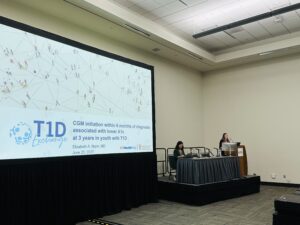
Sign up for a new account.
And get access to
The latest T1D content
Research that matters
Our daily questions
Sign up by entering your info below.
Reset Your Password
Don't worry.
We will email you instructions to reset your
password.
At this year’s American Diabetes Association 83rd Scientific Sessions, T1D Exchange presented three oral presentations, two panel discussions, and fifteen abstracts.
Amongst this research, T1D Exchange is honored to receive the 2023 President’s Award for research from our Quality Improvement Collaborative (T1DX -QI): “CGM Initiation within Six Months of T1D Diagnosis Associated with Lower HbA1c at 3 Years.”
The T1DX-QI brings together 54 endocrinology centers across the country, collectively treating more than 85,000 people with T1D and 15,000 people living with type 2 diabetes (T2D), to identify and address gaps in care and accelerate evidence-based, practical solutions. The resulting work of the T1DX-QI strives to improve diabetes patient care throughout the U.S.
Presented at the ADA’s Scientific Sessions — by Elizabeth Mann, MD, an endocrinologist at the University of Wisconsin — here’s a look at the results of this quality improvement work.
About the study: early initiation of CGM use after T1D diagnosis
 This quality improvement work investigated the impact of early CGM use in both adults and youth within six months of being diagnosed with type 1 diabetes (T1D).
This quality improvement work investigated the impact of early CGM use in both adults and youth within six months of being diagnosed with type 1 diabetes (T1D).
Involving nine endocrinology clinics participating in the T1DX-QI, it wouldn’t be possible without dedicated healthcare professionals from each participating center:
- University of Wisconsin, School of Medicine & Public Health
- Children’s Hospital of Los Angeles
- Cohen Children’s Medical Center, Northwell Health
- Stanford Medicine
- S. Mott Children’s Hospital, Michigan Medicine
- NYU Langone Health
- Barbara Davis Center for Diabetes, University of Colorado
- Texas Children’s Hospital
Authors of this study include: Saketh Rompicherla, MS, Nudrat Noor, PhD, Brian Miyazaki, MD, Lauren Golden, MD, Jennifer Sarhis, MD, Halis K Akturk, MD, Joyce Lee, MD, Daniel J. DeSalvo, MD, Patricia Gomez, MD, Osagie Ebekozien, MD, MPH, CPHQ, and Priya Prahalad, MD.
Study objectives
“The majority of youth with T1D do not achieve glycemic targets,” explained Mann, “despite advancements in diabetes technology.”
Research has determined the same in adults with T1D.
- Identify the benefits of CGM use in youth with T1D
- Gather evidence for the early use of CGM after diagnosis
- Address implications and barriers to early CGM use
While technology is only one component of diabetes management, CGMs offer a level of awareness, safety, and data that finger sticks cannot.
While CGMs have become a standard of care for many, there are still many who are not introduced to CGMs early in their diagnosis or who cannot access the technology due to costs and lack of insurance coverage.
Study results
The study concluded that early interventions within the first six months of diagnosis can significantly:
- Improve HbA1c levels
- Decrease risk of diabetes ketoacidosis
- Decrease risk of severe hypoglycemia
- Decrease risk of diabetes-related complications
The overall potential is clear: early CGM initiation can result in better quality of life with T1D.
Study limitations and barriers
- Disparities in who can access CGMs
- Logistical barriers to CGM initiation at diagnosis
- Public insurance coverage varies by state vs. private insurance
- Variables in clinical care across different endocrinology centers
“Early initiation of CGM as early as diagnosis and the timing of access thereafter is dependent on multiple factors including insurance policies, clinical resources, and family factors,” explained Mann.
“For some patients, initiating CGM may not be possible before three months or six months. Coverage and [prior authorization] processes for public insurance are variable by state which also influences access and timing of initiation. But insurance does not solely account for the disparity because we found no difference between CGM groups based on insurance types.”
What’s next?
“Multi-institution analysis that shows that for individuals able to initiate CGM within six months of diagnosis, long-term A1c improvement was seen compared to those who start later and those who do not start a CGM,” said Mann.
Additional reflections include:
- CGM initiation should be considered regardless of age, gender, insurance type
- CGM users are more likely to pursue insulin pumps and hybrid pump technology
- CGM users are less likely to be non-Hispanic Black
The T1DX-QI’s work doesn’t stop here. Next, T1D Exchange will focus on:
- Developing systems to support early CGM initiation
- Creating education for patients and families
- Removing barriers to access, largely by continuing health equity
CGM technology is clearly a critical part of improving and managing blood glucose levels — and plays a vital role in the daily safety of a person taking insulin. This work reminds us that CGMs should be a standard of care, offered to people early after diagnosis.







